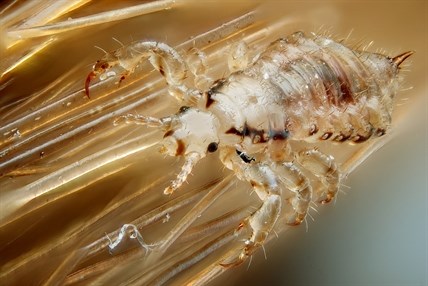
Male head louse.
Image Credit: Wikipedia Commons
March 19, 2014 - 2:49 PM
THOMPSON-OKANAGAN — Lice. The word alone is enough to incite a fever of head scratching in many people. But what happens when your kid brings a louse or two home? Do you clean everything or nothing? Does it mean your kid needs to have more baths? And just how do you get rid of those nasty little suckers?
Head lice is an annual occurrence at many elementary schools and daycares, something that turns into a huge nuisance and a ton of work for parents, but because the children tend to play in such close proximity it can be difficult to manage.
“They've been at every school I've ever been at.... I'm pretty certain at any given time it's in the school somewhere,” Kamloops Thompson School District Assistant Superintendent Karl deBruijn says. “There's no good way to manage it in schools.”
DeBruijn was not too concerned about a recent report that said more than 97 per cent of all lice on Canadian heads is now 'super lice' or 'mutant lice.'
"I haven't heard anything about that," he says, adding he hasn't noticed any changes in numbers or frequencies.
Interior Health Authority also hasn't heard anything about the mutated lice, though the study says B.C. is one of the three provinces it looked at.
While he has had one parent suggest fumigating the schools to get rid of the lice deBruijn explains this is just one example of why they try so hard to educate parents about proper treatment and the basic entomology of the annoying parasites.
So what can parents do when they realize their child has lice, or they get a letter home warning there has been lice found on one of their classmates? Proper checks, removal and cleaning of things like bedding and hats are some of the most important steps, along with notifying the school.
Quick facts on head lice:
-Sleepovers, sharing brushes and group selfies can be great agents of exchange.
-Lice checks used to be conducted in schools but that has stopped mostly because they stigmatized students.
-Winter months tend to be the worst for lice in schools.
-Lice have claws that allow them to cling to and climb hair.
-Louse is what a single live lice is called.
-Nit is the egg and tends to look like dandruff.
-Nits are layed close to the scalp and stick to the hair.
-Eggs hatch 1-2 weeks after being layed.
-Lice can only live off the head for a couple days.
-Lice feed on extremely small amounts of blood drawn from the scalp (which can cause the itching.)
-An adult louse is the size of a sesame seed.
-Lice can be hard to spot because of the size, colour and speed they move.
-If one person in the house has lice, it is likely someone else will have lice too.
-Pets do not get lice.
-Having dirty hair does not cause lice.
-Several non-prescription treatments are available over the counter for treating lice.
-The following items are not recommended for treating lice; insect sprays, motor oil, gasoline, alcohol, flea soap, dyes, bleaches, heat applied to the scalp, garlic, essential oils, and shaving the head.
To contact a reporter for this story, email jstahn@infotelnews.ca or call 250-819-3723.
News from © iNFOnews, 2014